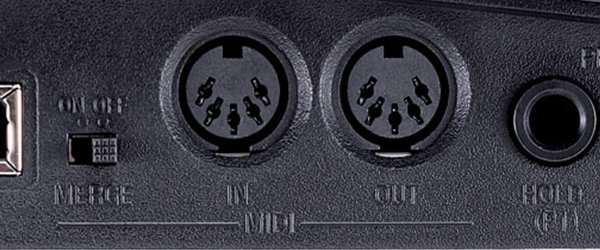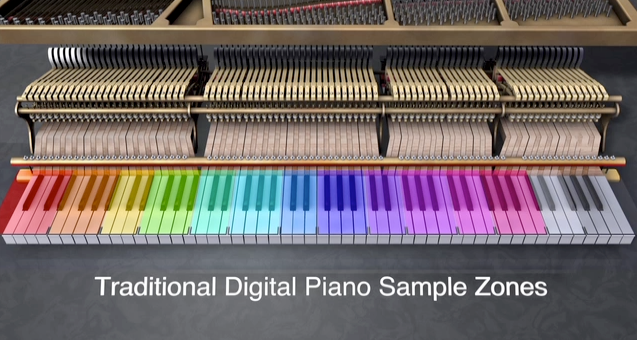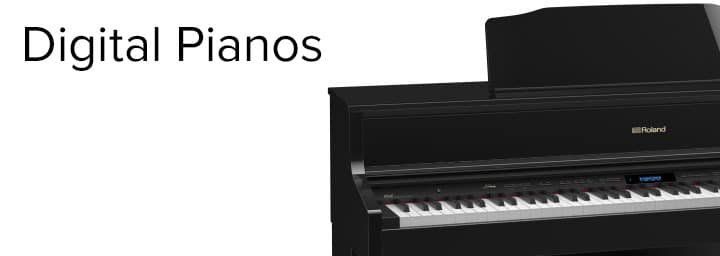What is the difference between an acoustic and digital piano?
This digital pianos FAQ is based on questions that we get from customers. Hopefully help you in deciding and understanding more about digital pianos and which one would be right for you – even if that’s an acoustic one! (Which Roland don’t actually make.)
 Buying a digital piano, especially your first one, can be confusing. This is due to the number of types and styles of piano. Sales people tend to use technical terms and jargon that can be confiusing. We will explain the differences between the main types of pianos and provide a handy digital piano jargon buster.
Buying a digital piano, especially your first one, can be confusing. This is due to the number of types and styles of piano. Sales people tend to use technical terms and jargon that can be confiusing. We will explain the differences between the main types of pianos and provide a handy digital piano jargon buster.
Digital Pianos can be divided into two categories depending on their intended use. Upright digital pianos and Digital Grand Pianos are generally intended for use in the home. Stage Pianos are designed for the performing musician who needs something more portable. Exterior design is the major difference in these categories. Many stage and home pianos share the same electronic “guts” and sounds. Upright & Grand digital pianos incorporate not only the sounds of a piano, but traditional cabinet design elements as well. Upright digital pianos are an ideal choice for the home, while stage pianos are ideal for live performance.
1. What is the difference between an Acoustic Piano and a Digital Piano?
2. What is the difference between a Digital Piano and an Electronic Keyboard?
3. So do you want a digital piano or an acoustic piano?
4. What kinds of digital piano are there?
Contributed by Roland UK Team and Mark van der Sluis
What is the difference between an acoustic and digital piano?
Here are the main differences between acoustic and digital pianos.
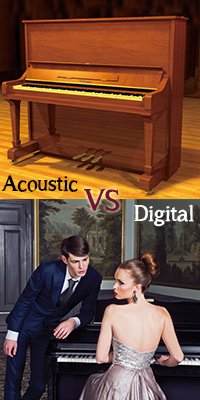 Essential elements of the Acoustic Piano are: its wooden cabinet/case, wooden soundboard (serves as the amplifier & speaker in an acoustic piano), cast iron frame, metal strings, 88 keys, hammers and the action. It is commonly accepted that there are between 6,000 – 10,000 moving parts in an acoustic piano! It is because of this that acoustic pianos require regular maintenance, regulating and tuning.
Essential elements of the Acoustic Piano are: its wooden cabinet/case, wooden soundboard (serves as the amplifier & speaker in an acoustic piano), cast iron frame, metal strings, 88 keys, hammers and the action. It is commonly accepted that there are between 6,000 – 10,000 moving parts in an acoustic piano! It is because of this that acoustic pianos require regular maintenance, regulating and tuning.
In contrast, digital pianos have considerably fewer moving parts. They still have a cabinet, but use speakers & amplifiers instead of needing a soundboard. Instead of needing so many delicate parts and materials in the action, digital piano actions are comparatively more simple and compact. Important: Not all digital piano actions are the same and not all digital piano actions have the same ‘touch or feel’ as an acoustic piano. So, do your homework thoroughly if you decide a digital piano best suits your needs.
Digital pianos have come of age in much the same way that digital cameras have. Initially, digital cameras were met with some skepticism. After all, how could they take better photos than my trusty 35mm Kodak camera, right? Well, like most other digital products, new technologies were developed offering better performance. This included new features, better quality and they became easier and more fun to use, more affordable and now they are universally accepted as the ‘norm.’ Digital pianos have evolved in much the same way.
What is the difference between a Digital Piano and an Electronic Keyboard?
Electronic keyboards are typically smaller than a piano in that they tend to have either 49 or 61 keys (4 or 5 octaves). This is quite different to a traditional piano with 88 keys (6 octaves). Keyboards are portable, light-weight and often provide a wider range of sounds. They also have the ability to interact easily with computers via MIDI or USB connections (more on that later.)
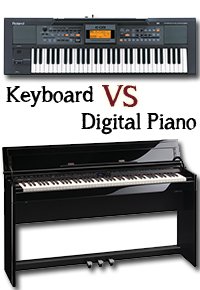 When playing an electronic keyboard you will notice that the keys are slightly smaller and easier to press than an acoustic piano. This may take some getting used to for a pianist that is used to playing on an acoustic piano. The reason that the acoustic piano is heavier is because:
When playing an electronic keyboard you will notice that the keys are slightly smaller and easier to press than an acoustic piano. This may take some getting used to for a pianist that is used to playing on an acoustic piano. The reason that the acoustic piano is heavier is because:
(1) the keys are made of wood
(2) they are triggering a ‘hammer’ that strikes the string and makes noise and
(3) gravity plays more of a role in the physics of a piano action (especially a grand piano)
Electronic keyboards simply have plastic molded keys. Since the keys are lighter and smaller, keyboards and some digital pianos are sometimes easier for those younger fingers!
Keyboards are not trying to be a substitute for a piano. Yes, they have piano sounds but they do not feel or respond like a piano. Even though most keyboards these days are touch sensitive, they do not have the same dynamic range or expressive capabilities of an acoustic or digital piano. They are great however, if you want hundreds of sounds and rhythms with accompaniment. And if you’re not a pianist, this is the easiest way for you to sound good and impress your friends! Unlike playing the piano, (if you cant play it well, everybody will know!) you can use a finger on each hand and sound like a complete band!
So do you want a digital piano or an acoustic piano?
Check to see if you answer ‘YES’ to any of the following questions. If so, it would indicate that your needs are more suited to digital piano rather than an acoustic.
• Do you want to position your piano near a fire place/heater/air conditioning unit or a window?
Acoustic pianos contain materials such as wood and felt, and are subject to change with climatic conditions. Extreme swings from hot to cold or dry to wet cause its materials to swell and contract, affecting tone, pitch, and action response or touch.
 • Do you want to position your piano on an outside wall of your house?
• Do you want to position your piano on an outside wall of your house?
It is usually recommended that acoustic pianos be positioned only on internal walls. This is to avoid the risk of extreme changes in temperature often associated with outside walls affecting the piano.
• Do you want your piano upstairs?
Moving an acoustic piano upstairs is heavy work, costly, difficult and there is a risk of doing damage to the piano and surroundings.
• Do you want to play at night or other times without disturbing your family or neighbours?
Digital pianos have a Master volume control as well as headphones for silent playing.
• Do you want to avoid regular tuning and maintenance costs?
Acoustic pianos cost between $150-$250 on average to tune, excluding any maintenance/repair work.
• Do you want to spend less than $3,000 but still want a good quality instrument?
Cheap acoustic pianos are sold more on their furniture value rather than their virtues as an instrument.
What kinds of digital piano are there?
So, at this stage, you’ve pretty much decided that you want a digital piano. There is a mind-boggling array of different types, styles, brands and prices out there! In an attempt to simplify the choice start by deciding which of the following you require:
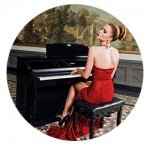 Upright digital pianos
Upright digital pianos
An upright piano is designed to sit up against a wall. These pianos are more suited to home and they are built to be aesthetically pleasing and resemble the appearance of an upright acoustic piano.
Stage digital pianos
Also known as a ‘portable piano’, a stage piano is designed for use in a live band/performance situation. While stage pianos share some of the same features as digital pianos designed for home, they have a number of features that set them apart. This type of digital piano normally makes no attempt to imitate the physical appearance of an acoustic piano. Instead, they rather resembling a modern synth or music workstation.
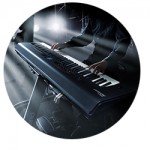
A distinguishing feature of most stage pianos is a lack of internal loudspeakers and amplification. It is normally assumed that a powerful keyboard amplifier or PA system will be used. They often have a heavier, more robust body, which is better able to withstand the stress of heavy touring. Unlike digital pianos designed for home use, they do not have a fixed stand or fixed sustain pedals. Instead, they are designed to be used with a separate portable stand and portable sustain pedals.
 Digital Grand Pianos
Digital Grand Pianos
A classic grand piano gives a room presence. However, the traditional acoustic beauty can come with high-maintenance issues. They need to be tuned, are susceptible to climatic conditions, and moving them is cumbersome. Top of the range digital grand piano manufacturers such as Roland offer the same silhouettes and sounds, yet they are easy to move and never need tuning. Unlike traditional grand pianos, the volume can be controlled from soft background music all the way to concert volumes. The action of the keyboard simulates the feel of a true acoustic grand with amazing accuracy.
Quick glossary of digital piano terms and phrases
There are a fair number of technical terms and jargon that are banded around in the world of digital pianos. Here are some important ones to get your head around. Hopefully you won’t be baffled by the sales guy next time you walk into a piano shop!
Action is a term you will come across various terms relating to the response of the keybed. Weighted, semi-weighted, synth, and hammer action each offer a different feel. Weighted and semi-weighted actions have a response similar to a traditional piano. Hammer action adds actual mechanical hammers to enhance this response even more. Synth action is more like an organ; there is no resistance and the keys can be played very quickly. If you’re accustomed to the feel of a piano, you’ll want a keybed that’s weighted or semi-weighted. Perhaps with hammer action if you really want a true piano feel. If you’re the type of player who plays a lot of fast lead passages, a synth-action keybed will probably suit your needs better.
Auto Accompaniment is a feature that produces a rhythmic, albeit rather simple pattern. This can also produce a chordal/arpeggiated accompaniment. (Also known as a ‘Music Style’.)
Dual Layer allows two (or more) voices to be played at the same time when keys are pressed.
Ebony Feel is a term used to explain the ‘feel’ of the black keytop surfaces. Ebony is a dense, black wood and is rare as well as expensive. Once used for the black keys on acoustic pianos, its feel provided a luxurious and smooth surface. Roland feature simulated ‘Ebony Feel’ keytops in their new PHA-4 Concert action.
Take a breath! There’s more…
Escapement is what allows the hammer to be released (escape). The hammer strikes the string and falls back, even if the key is still depressed. Without this ‘Single escapement’, the hammer would be held against the string (muting its vibrations) for as long as the key was depressed. What’s unique about the escapement, is the feel it has when you press a key. It has a strange ‘clicking’ feel when a key is depressed about half way down. This ‘clicking-feel’ is an integral characteristic of an acoustic piano action. All Roland digital piano actions feature the escapement, complete with the authentic ’clicking’ feel.
Flash Drive is a portable and/or removable USB memory device (e.g. pen drive). This is for storing compositions, user settings, performance data, audio files etc. for easy transfer to a computer or other device.
Ivory Feel is a term used to explain the ‘feel’ of the white keytop surface. Instead of the keys being the generic smooth (and sometimes slippery) white plastic. Ivory-Feel keys use a tactile and often moisture absorbing material to imitate the feel of genuine elephant-tusk ivory. This was banned for using on acoustic piano keys decades ago.
MIDI(Musical Instrument Digital Interface) is a communication protocol established in the 1980s. It was actually invented in 1983 by Ikutaro Kakehashi – founder of Roland Corporation and Dave Smith of Sequencial Circuits for electronic instruments and computers. MIDI messages contain no sounds as such, rather serving as a blueprint that tells a hardware or software instrument what notes to play and with what velocity. For example, a MIDI passage could be sent to a keyboard that in turn could play the same passage with any of the sounds available in the instrument. MIDI compatibility enables a keyboard to send and receive MIDI messages.
You’ve reached the halfway mark!
Escapement is what allows the hammer to be released (escape) from the influence of the key and the rest of the action. The hammer strikes the string and falls back, even if the key is still depressed. Without this ‘Single escapement’, the hammer would be held against the string (muting its vibrations) for as long as the key was depressed. When you press a key, it has a strange ‘clicking’ feel when it is depressed about half way down. This ‘clicking-feel’ is an integral characteristic of an acoustic piano action. All Roland digital piano actions feature the escapement, complete with the authentic ’clicking’ feel.
Flash Drive is portable and/or removable USB memory device (e.g. pen drive). This is for storing compositions, user settings, performance data, audio files etc. for easy transfer to a computer or other device.
Ivory Feel is a term used to explain the ‘feel’ of the white keytop surface. Instead of the keys being the generic smooth (and sometimes slippery) white plastic. Ivory-Feel keys use a tactile and often moisture absorbing material to imitate the feel of genuine elephant-tusk ivory. This was banned for using on acoustic piano keys decades ago.
MIDI(Musical Instrument Digital Interface)is a communication protocol established in the 1980s. It was actually invented in 1983 by Ikutaro Kakehashi – founder of Roland Corporation and Dave Smith of Sequencial Circuits. MIDI messages contain no sounds. They serve as a blueprint that tells a hardware or software instrument what notes to play and with what velocity. A MIDI passage could be sent to a keyboard that in turn could play the same passage with any of the sounds available in the instrument. MIDI compatibility enables a keyboard to send and receive MIDI messages.
The final straight!
Sequencer is a hardware or software device that records MIDI performance data. It then plays it back in a user-programmed sequence. Think of it as a 21st-century player piano.
Sound module is an external device that has a huge library of voices saved on it. This can be connected via MIDI to your keyboard, which allows you to access the voices on the sound module. This significantly expands the options available to you on your digital piano.
Split allows you to split the keyboard at any given point on the digital piano that allows you to play a different instrument within a particular zone. Mostly, digital pianos will allow you to split the keyboard into two zones. This will allow you to play one instrument with the left hand and a different one with the right hand.
Storage for digital pianos or keyboards offer internal storage options such as USB flash drives, SD cards, CD burners, or hard drives. Others offer external solutions such as USB connectivity. As a result, you can transfer data between your computer and other USB-enabled devices and your digital piano or keyboard.
Supernatural Piano Technology enables your digital piano to combine all the benefits of both an acoustic and a digital piano in one like never before. In 2010, Roland launched SuperNATURAL Piano technology. SuperNATURAL Technology, brings together Roland V-Piano Modeling technology and 88-key stereo multi-sampling technology. This new sound engine is the product of more than 10 years R & D by Roland Japan’s engineers. They have painstakingly recreated all of the characteristics and subtle nuances of acoustic pianos. SuperNATURAL technology has three main components:
(1) Organic Tonal Change
(2) 88-Key Stereo Multi-Sampling and
(3) Natural Decay. SuperNatural Piano technology is only available in Roland Digital Pianos.
The last few terms!
Synthesizer closely related to the digital piano except for the fact that it does not necessarily have to specialize in simulating a piano. They typically produce a wide variety of sounds by generating and combining signals of different frequencies.
Tones are Roland’s term for an instrument or sound on your keyboard. So if they say there are 300 tones included in a digital piano, they are saying there are 300 different instruments on that digital piano. Most digital pianos will come with at least 8 tones or sounds, e.g. Electric Piano 1, Strings, etc.
Touch or velocity Sensitive is a term that refers to whether the keys responds to how hard/soft you strike them (also known as ‘velocity’). Varying levels of touch sensitivity will either restrict or enable authentic expression & dynamics when playing. Acoustic grand pianos are considered the most expressive instrument to play because the volume, tonal colour and nuances of each note change with the slightest variation in velocity. Digital pianos are not all created equal when it comes to replicating this depth of expression. However, Roland’s SuperNATURAL piano technology delivers an authentic playing experience.
Triple (Tri) Sensors is a device that detects the speed with which the keys are played to determine how hard it is hit. Hit the key softly and you will hear a soft sound; hit it with more force and it becomes louder and brighter. In January 2014, Roland introduced High-Resolution Sensor Technology into their digital piano range (More than 100 x faster than standard sensors), which deliver incredible accuracy, dynamic range (ppp to fff) as well as lightning fast response.

